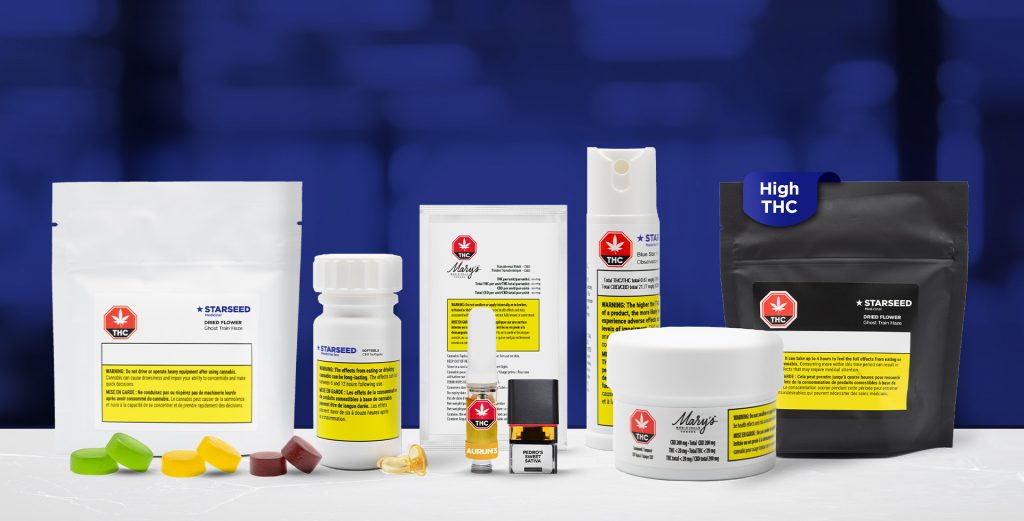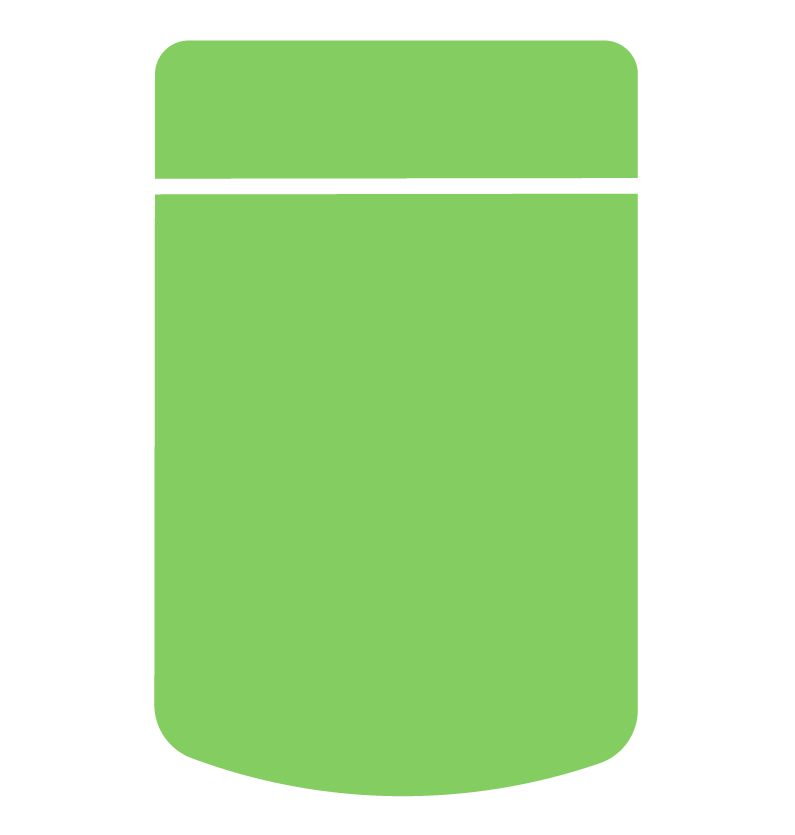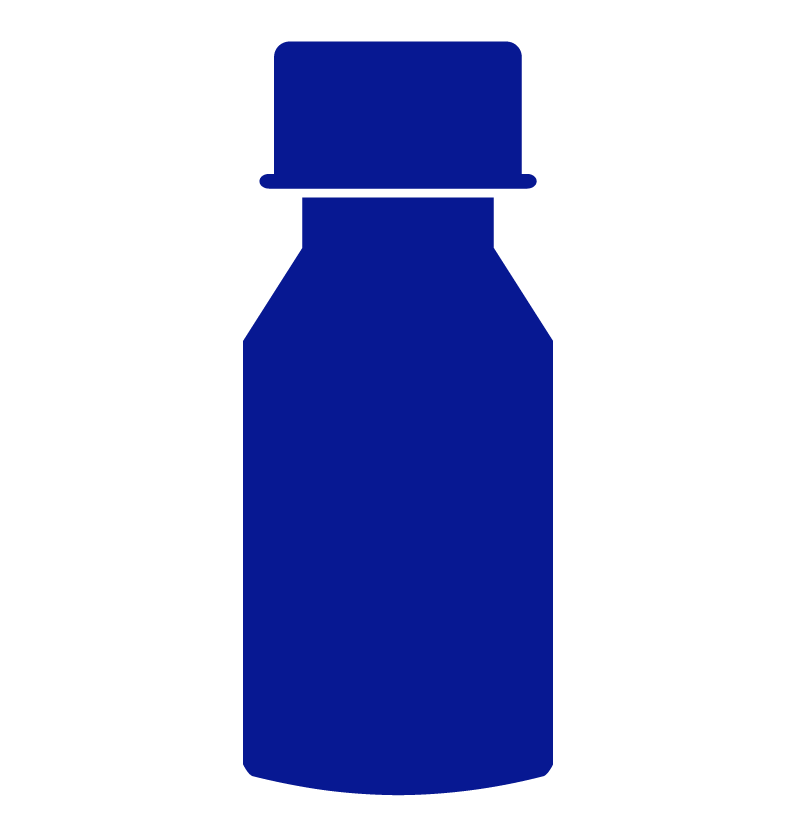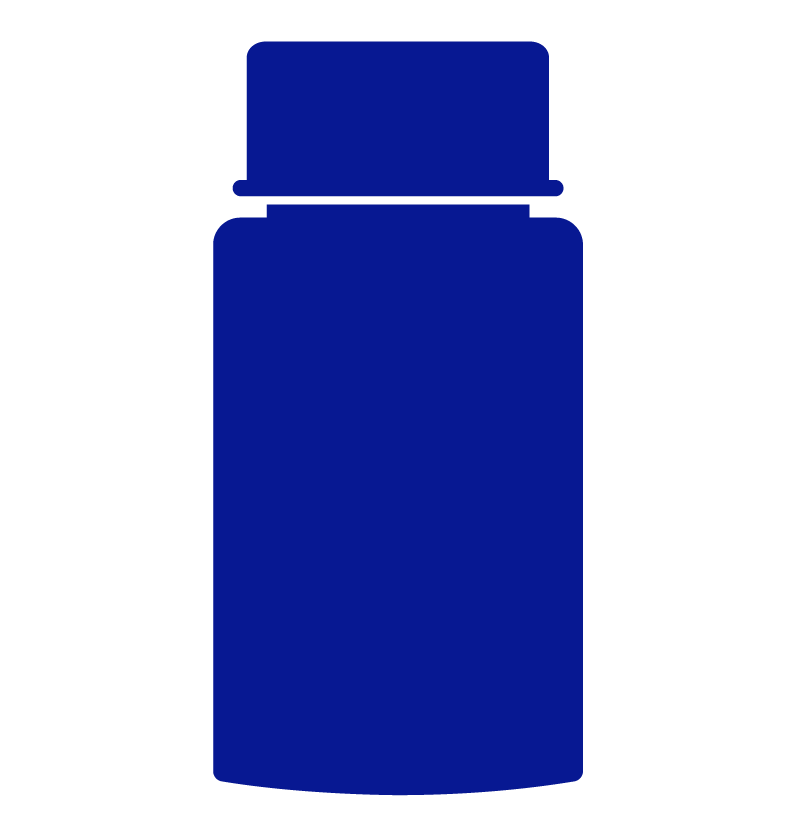Medical cannabis labels contain important details about the products within the package. This is where you will find all the information you need to understand what you are consuming.
Starting with the front label, here is a detailed guide on how to make sense of it:
Front Label
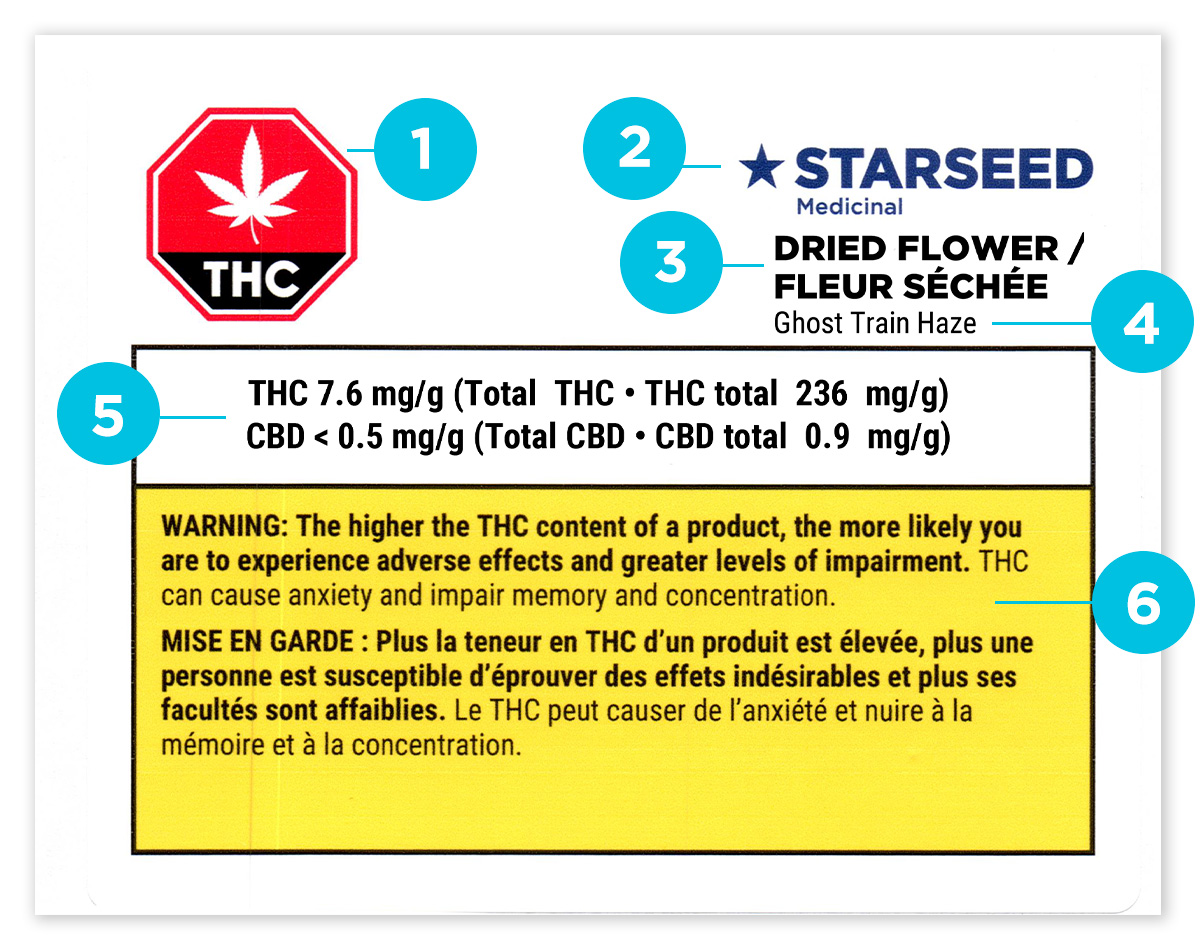
1. Standardized Cannabis Symbol
This symbol is required on the front of cannabis products that contain more than 10 micrograms per gram of THC. It is used to warn consumers that the product contains THC. The symbol is a white cannabis leaf inside a red hexagon, bearing the abbreviation “THC” on a black background.
2. Brand Name
The Licensed Producer’s company brand name and logo.
3. Class of Cannabis
The type or class of cannabis the product belongs to. This is the format of the cannabis product that is being purchased. The categories can include:
· Dried Flower
· Cannabis plant seeds
· Vapes, Inhalers
· Edible cannabis – soft chews, chewing gum, chocolates, etc.
· Cannabis extracts – oils, softgels
· Cannabis topicals – compounds, patches, lotions
4. Cannabis Cultivar/Product Name
The name of the unique product that is in the package. It could be listed as the cannabis cultivar or the brand’s product name for the item.
5. THC and CBD
The potency of the two primary cannabinoids, THC and CBD. To help consumers make informed decisions, the amounts are shown in two ways:
· “THC” and “CBD”
· “Total THC” and “Total CBD”
When cannabinoids are exposed to heat or oxygen, a process called decarboxylation, they become activated. When cannabis is decarboxylated, its cannabinoid levels increase.
The first numbers on the label, listed as “THC” and “CBD”, represent the active cannabinoid levels in the product. Dried cannabis will have a lower level of active cannabinoids because it has not been decarboxylated yet.
The second set of numbers listed as “Total THC” and “Total CBD” represent the active cannabinoid levels in the product when it is ready for consumption. Oils, softgels, vapes, inhalers, soft chews and topicals will have the same numbers for both “THC” and “CBD”, and “Total THC” and “Total CBD” because the cannabinoids were activated during production and do not need to be decarboxylated further for consumption. For dried flower, this number will be higher because the cannabinoids will increase once heated.
The amount of THC and CBD in a product can be presented in different ways:
· Amount by weight: If a 7-gram package of dried cannabis is labeled as “THC 180 mg/g”, it means the entire package contains 1,260 mg of THC (180 mg multiplied by 7 g).
· Amount by unit: If a package of 4 pieces of edible cannabis is labeled as “THC per unit 2.5 mg”, it means the entire package contains 10 mg of THC (2.5 mg multiplied by 4 pieces).
· Total amount: If a package of edible cannabis is labeled as “THC 10 mg”, it means the entire package contains 10 mg of THC.
· By activation: If an oral spray is labeled as “Total THC per activation 2.5 mg”, it means that 2.5 mg of THC will be dispensed per spray.
Handy Tip – Converting potency from mg/g to %:
Converting mg/g to % is simple – move the decimal point one spot to the left and you’ll determine the percentage of THC or CBD.
For example, if the potency for dried flower is listed as 246 mg/g of Total THC, then it contains 24.6% THC.
To do this conversion, always use the “Total THC” or “Total CBD” listed.
6. Standardized Health Warning:
A message highlighted in yellow that includes a warning about the potential health risks and effects of using cannabis. All cannabis products must have a health warning message on the front of the product label. There are several health warning messages created by Health Canada based on the most recent scientific research findings on cannabis.
Back Label
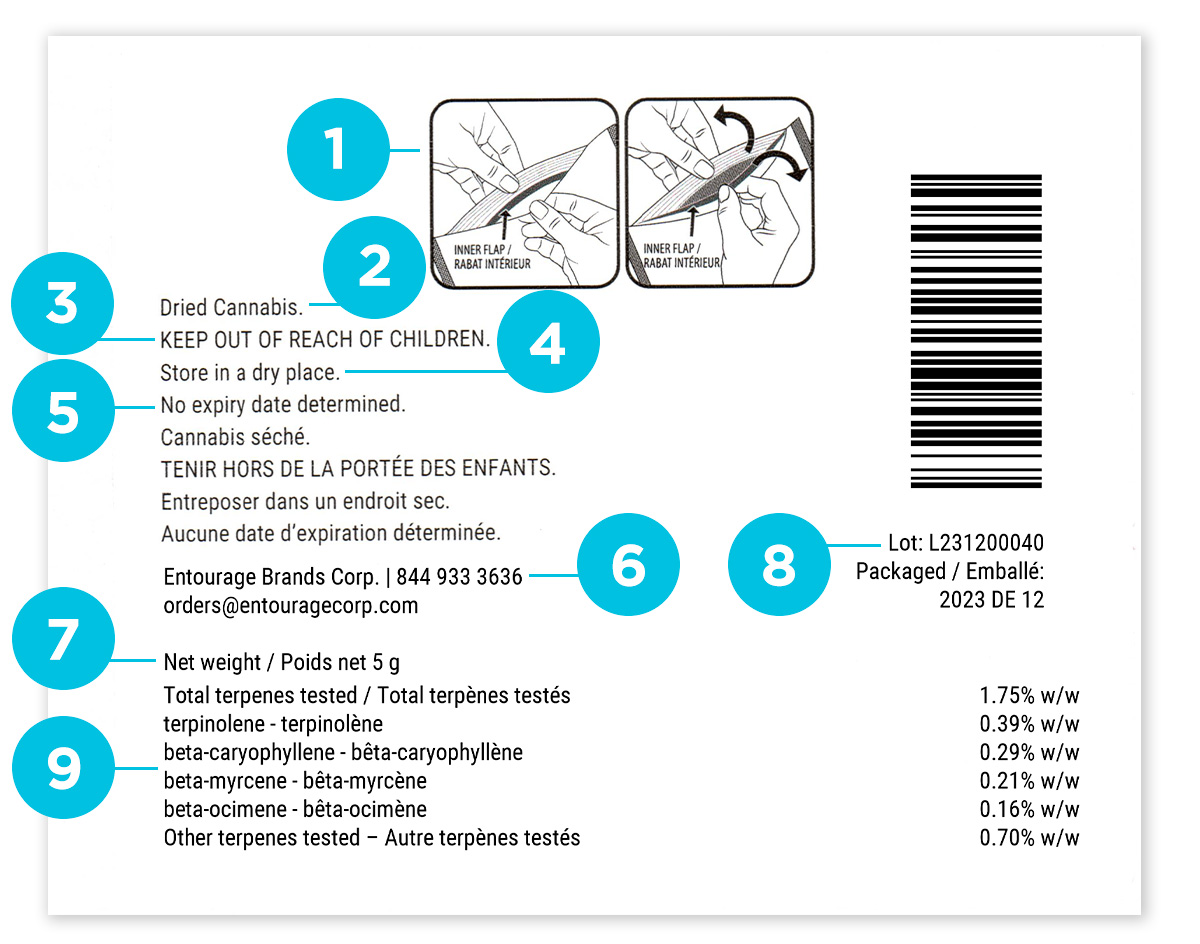
1. How to open the package infographic
Different styles of packaging can be difficult to open. The infographic is a step-by-step guide on how to open the packaging properly so that it can be resealed after use.
2. Class of cannabis product
See #3.
3. Warning Statement
All product labels need to indicate “KEEP OUT OF REACH OF CHILDREN / TENIR HORS DE LA PORTÉE DES ENFANTS”.
4. Recommended storage conditions
The recommended storage conditions such as temperature, light conditions, or humidity to ensure the product’s quality.
5. Expiry Date
Expiry dates are used to communicate the stability of the product regarding potency. Edibles must have a durable life date (“best before”) if the quality of the product will degrade within 90 days of manufacturing. This does not mean the product expires or is unsafe for consumption after the date, but its potency, flavour, texture or freshness may have changed.
6. Licensed Producer’s Contact Information
The contact details how to contact the Licensed Producer.
7. Net Weight and Number of Units / Dried Cannabis Equivalent
The total weight of the product per package and per unit if applicable. The number of individual pieces that are within a package – such as 4 soft chews or 20 softgel capsules.
Cannabis extracts and edibles will include the Dried Cannabis Equivalency on the label. This information can help you determine if you’re within the public possession limit of 30 grams. Medical cannabis patients may be authorized to carry up to 150 grams or a 30-day supply of dried cannabis or the equivalent, in addition to the 30 grams allowed for non-medical purposes.
8. Lot Number and Packaging Date
The Lot number refers to a specific harvest or “lot” of products, which helps the Licensed Producer to trace it back to their quality control processes.
The packaged date refers to when the product was sealed in its final packaging.
9. Other Information – Terpenes, Ingredients
Licensed Producers can choose to list the terpenes tested in the unique Lot of the product. The first line “Total Terpenes Tested” indicates the total percentage that is present in the product. The specific terpenes are listed in descending order of dominance.
A list of ingredients is required on the product label for:
· cannabis extracts
· cannabis topicals
· edible cannabis
Ingredients are listed in descending order of weight. This means that a product contains more of the first ingredient and less of the last ingredient on the list of ingredients.
Understanding a cannabis label is an important part of making educated and informed decisions about the products you are consuming. There is a lot of information that can be found on the label but once you know what they mean, it can be extremely helpful. Be sure to read every label carefully to find the information you need before consuming.
